Overview of the Company
- Lions Share, Inc. is the virtual company in the Marketplace simulation.
- Our team was running it for the past six weeks.
- We considerably succeeded in the given period.
- The company’s brands are in the top-5 of every three markets in the simulation.
Greetings to the audience! My name is STUDENTNAME. I am about to present you an overview of Lions Share, Inc.’s accomplishments to provide a proper context for the development of guidelines for further growth. Our team has been running the virtual company for the past six weeks in the Marketplace simulation. I can state that we succeeded considerably since the company’s brand are in the top-5 of every three markets in the simulation.
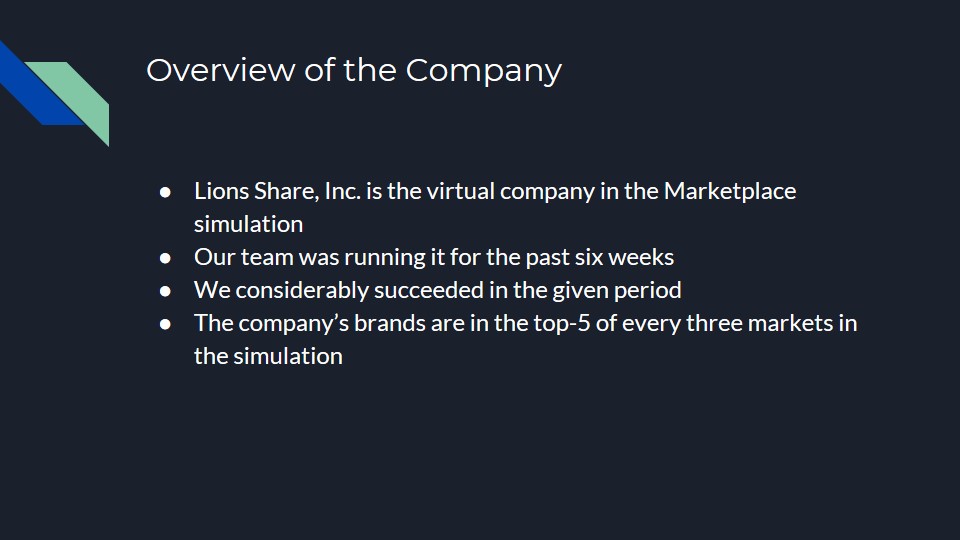
Statistics for Quarter 4
- Gross profit has multiplied by more than ten times from Quarter 2 to Quarter 3 (210 288 and 2 359 566 respectively), and from Q3 to Q4 it nearly doubled (4 260 166 as for the end of Q4).
- Operating profit, being negative during first two quarters, has reached the peak of 2 301 859 in Q4.
- Customer profitability has grown for every four brands of the company.
Further, it is essential to provide statistical data for the Quarter 4. First of all, gross profit has shown the immensely high pace of growth throughout the simulation. Operating profit, being expectedly negative at the beginning of the company’s operations, has grown considerably by the end of Quarter 4. Also, customer profitability index also increased for each of the company’s four brands.
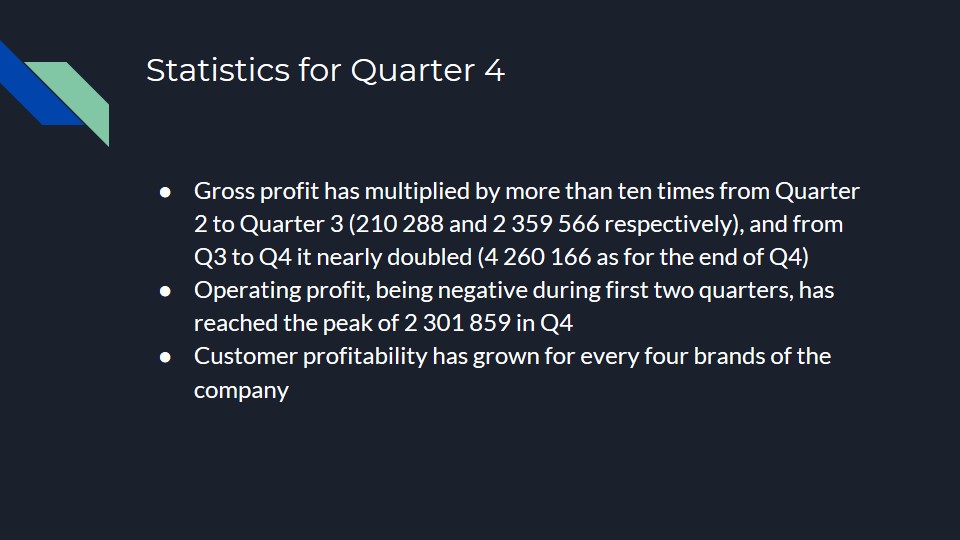
Brand profitability
- Leone 1. Gross profit: 296 746. Expenses: 0. Brand profit: 296 746. Profit per unit: 1 137.
- Leone HD. Gross profit: 531 777. Expenses: 90 000. Brand profit: 441 777. Profit per unit: 1 025.
- Lanza 1. Gross profit: 1 154 837. Expenses: 135 294. Brand profit: 1 019 543. Profit per unit: 695.
- Lanza 2. Gross profit: 376 206. Expenses: 101 836. Brand profit: 274 370. Profit per unit: 286.
It is important to dwell on the aspect of the company’s profitability. Profitability analysis is an essential aspect of any company’s success since it allows to investigate financial tendencies and develop strategies (Gaspar, Coric, & Mabic, 2015). We were given basic information about our financial performance, including brand revenues, gross profit, expenses, and overall brand profit. Based on this information, we were able to analyse our accomplishments, which are presented in this slide.
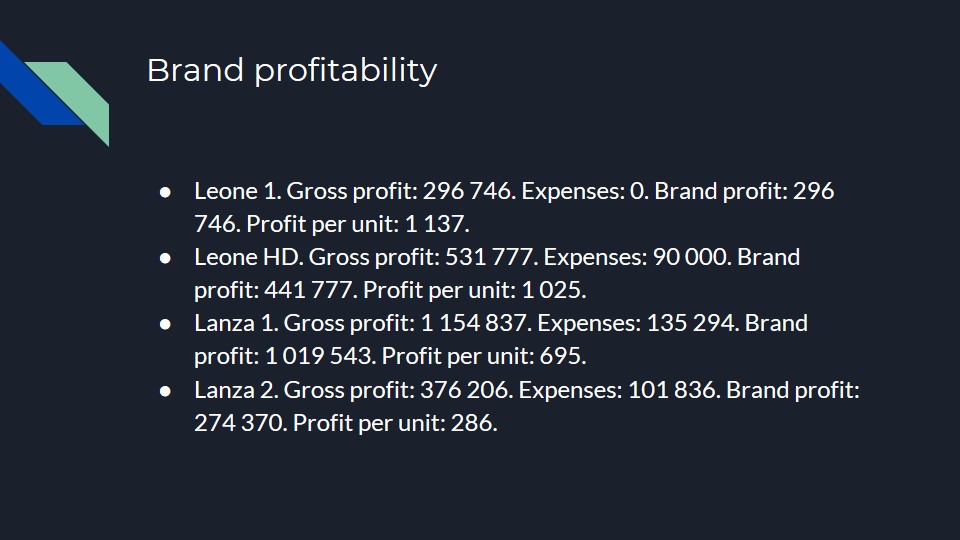
Virtual Team Development
- Adequate distribution of team roles.
- Every team member understands his or her responsibilities completely.
- Implementation of the four-step framework of developing a business model.
- Support from other theoretical sources.
One of the primary challenges of the Marketplace simulation is that it requires a successfully performing virtual team. The development of such team is a specific task, which requires the following aspects. First of all, it is essential to distribute the roles adequately. Then, every team member should obtain a complete understanding of his or her responsibilities. Also, it is important to implement theoretical frameworks. We chose the approach described by Riel and Martin (2014), as well as theoretical assumptions provided by Trainer (2010) and Tuckman and Jensen (1997).
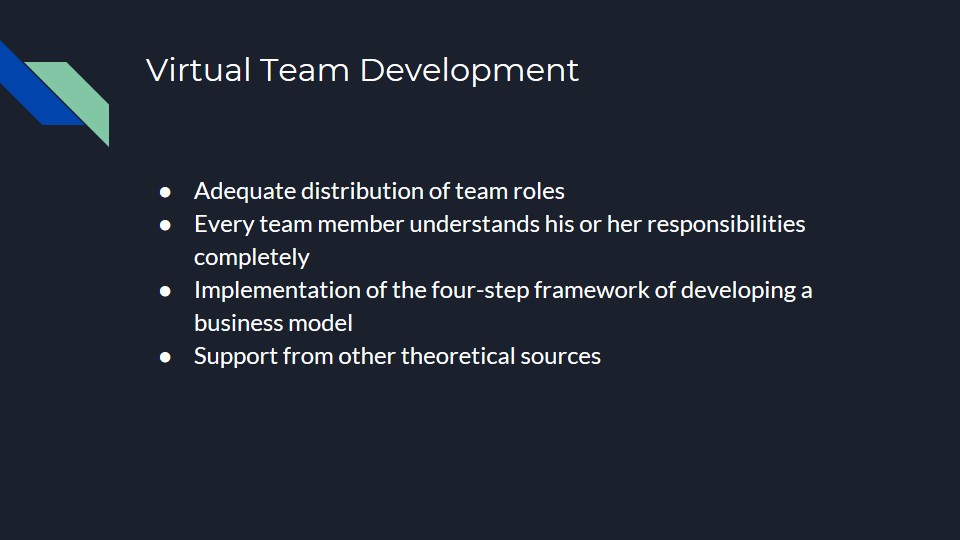
What could be done better?
- Understanding of the company’s deficiencies is essential.
- Lanza 1 and Lanza 2 models were introduced to the market with insufficient planning.
- Despite that the company benefited from its extension, marketing mix and positioning should have been developed better.
- The overall comparative analysis of the primary tendencies is required.
Since the company’s accomplishments have been overviewed, it is possible to dwell upon the shortcomings of our performance. One of the most evident drawbacks is the introduction of Lanza 1 and Lanza 2 models in the market. Even though that the company benefited from this extension, the team should have developed a marketing mix and positioning strategy. Also, the comprehensive analysis of the overall performance is required.
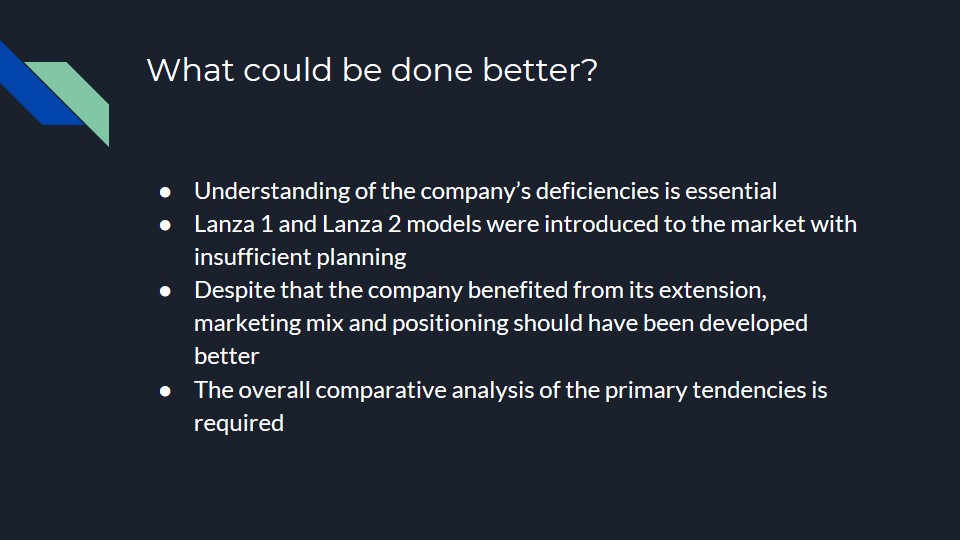
Developing future strategy
- Use of integrative thinking.
- Integration of experience.
- Problem-solving and decision-making techniques.
- Six-step model.
- Development of marketing mix statement.
- Risk management.
Further, it is of high importance to develop a comprehensive strategy for the company’s future successful development. I argue that there several aspects, which are essential for strategy building. First of all, it is critical to implement the principles of integrative thinking. Secondly, the employment of appropriate problem-solving and decision-making techniques is also needed (Cadle, Paul, & Turner, 2014). Further, a marketing mix statement should be developed. Finally, the implementation of risk management would help to minimize the possibility of adverse events.
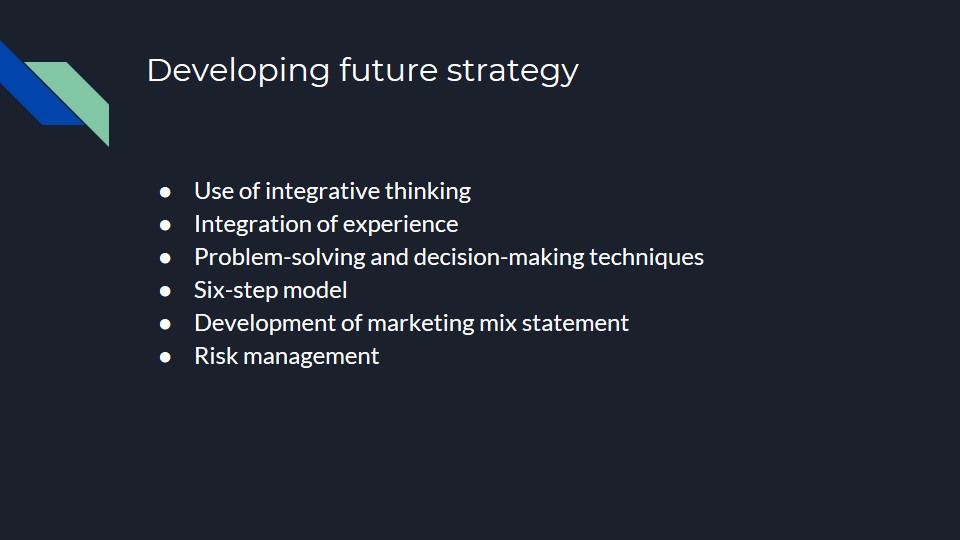
Integrative thinking
Four stages of integrative thinking:
- Articulate two opposing models.
- Examine the chosen models.
- Investigate possible outcomes.
- Test the prototype solutions.
The concept of integrative thinking is proposed by Riel and Martin (2014). The first step requires reducing the variety of possible solutions of the problem to two extreme opposites, which would decrease the uncertainty. After identifying the models and articulating them, it is essential to compare them in order to understand what is similar and what is different (Riel and Martin, 2014). Thirdly, based on the comparative analysis, it is important to develop a new comprehensive model. The fourth step is to test the developed prototype model.
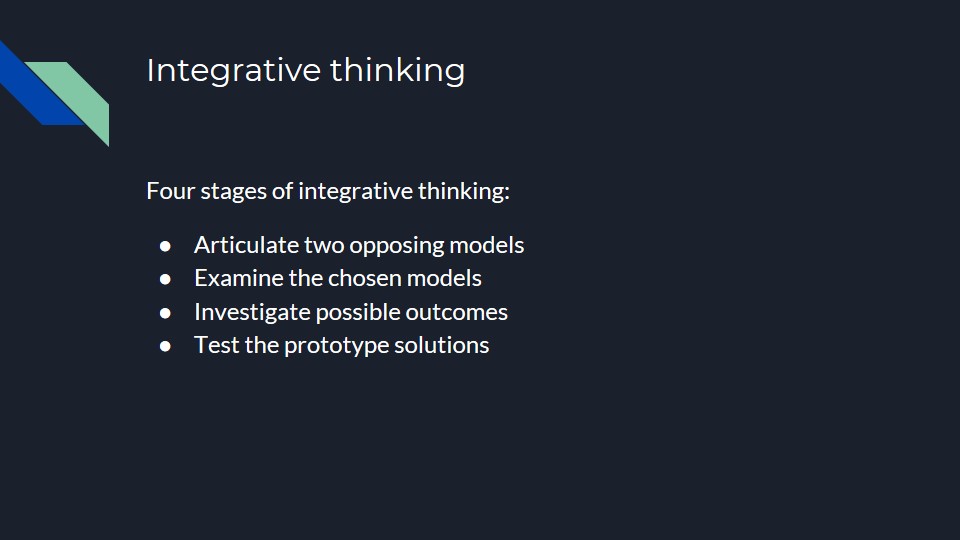
Integration of experience
- Integration of the experience gathered by the company during past six weeks.
- The inclusion of mistakes and underestimations into integrative thinking model.
- Improvement based on the included information.
As a part of integrative thinking model, it is appropriate to use the company’s gathered experience as a source for insights or solutions. It is evident that any company’s performance could be improved. Therefore, it is essential to make positive use of mistakes, errors, and underestimations made by the team. The analysis of the company’s experience, as well as other companies’ practices, is essential for further improvement of Lions Share, Inc.
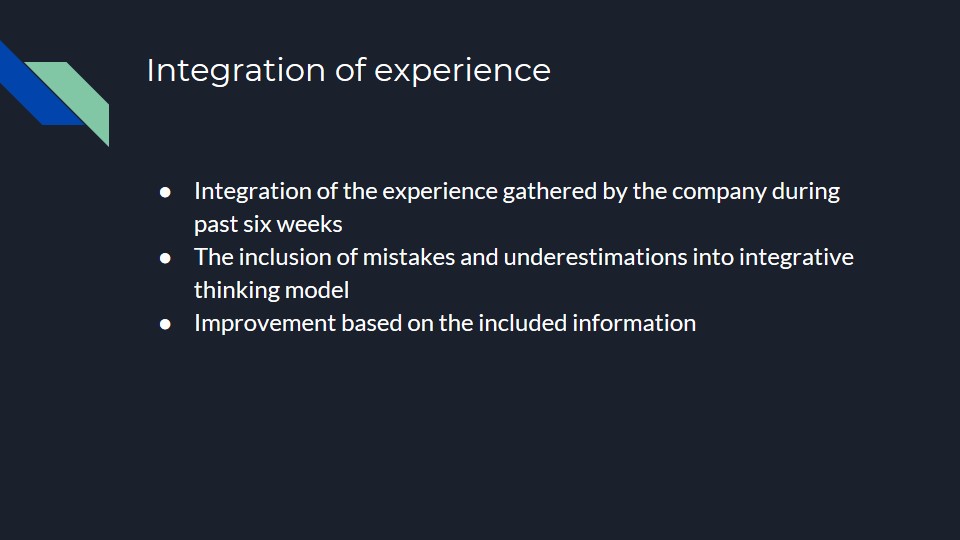
Six-step process
- Define the problem.
- Analyze the problem.
- Develop solutions.
- Evaluate solutions.
- Identify and implement the best solution.
- Monitor the progress.
The model, which is presented on this slide, is slightly different from the previous approach; however, it also aims to facilitate the process of finding the solution. First of all, it is essential to define and analyze the problem in order to retrieve maximum amount of applicable facts. Secondly, it is of high importance to develop and evaluate possible solutions to identify the most suitable one. After the implementation of this solutions, it is essential to monitor the progress.
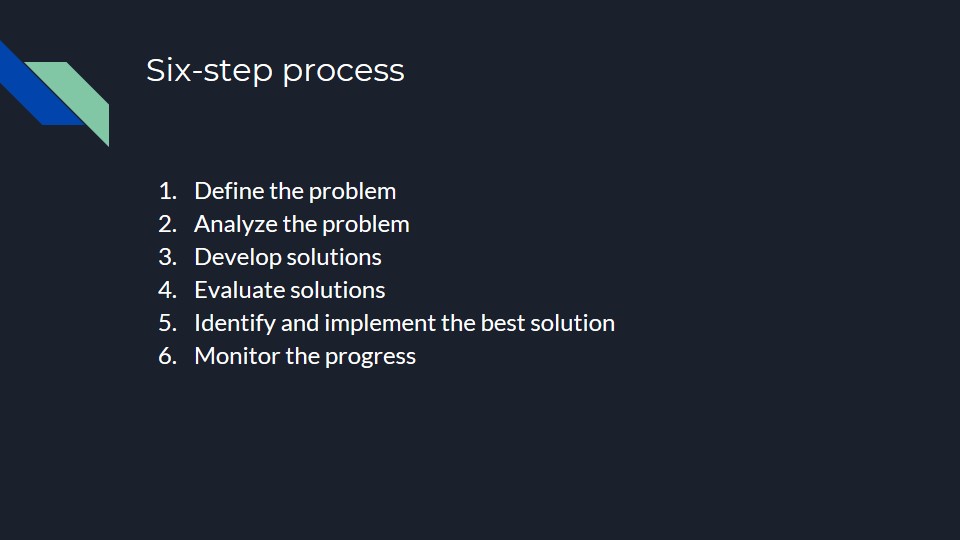
Marketing mix
- The concept of marketing mix significantly evolved in the digital era.
- Modern marketing mix should be based on customer mix.
- Modern 4 aspects of marketing: product, price, distribution, IMC.
Further, it is essential to discuss the development of marketing mix since it defines the company’s position in the market. First of all, one should understand that the concept of marketing mix has evolved considerably. Therefore, there significantly more opportunities for development as well as obstacles (Jackson & Ahuja, 2016). One of the critical claims is that marketing mix should be based on forming social, financial, structural, and relationship bonds with the customer (Jackson & Ahuja, 2016). Also, it is important to consider digital means of marketing (Jackson & Ahuja, 2016).

Risk management
Risk management is the principal tool for preventing and eliminating adverse effects. Aven (2016) proposes the following model:
- Evidence.
- Knowledge base.
- Broad risk evaluation.
- Decision-maker’s review.
- Decision.
Finally, it is of critical importance to discuss the implementation of risk management techniques since it allows to minimize the risks. Aven (2016) proposes a 5-step model of risk management, which is highly applicable to use in our company. The first three steps are performed by experts, who form the evidence and knowledge base by gathering facts (Aven, 2016). Further, the identified risks are evaluated by the experts, and then they are double-checked by the superior decision-maker, who makes the final decision (Aven, 2016).
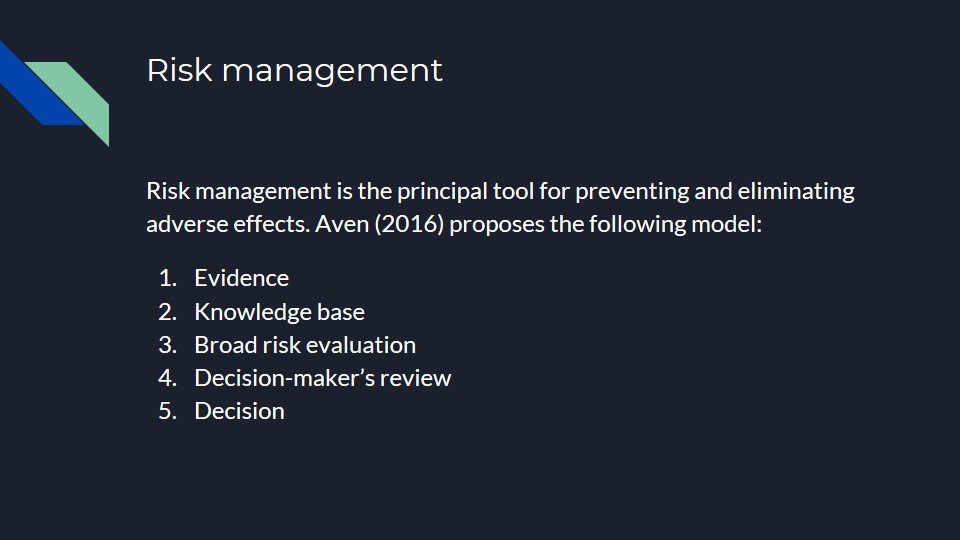
Conclusion
- Our company has succeeded considerably during the simulation process.
- We will employ our experience to develop and evolve.
- The employment of the mentioned techniques will help us to formulate an elaborated and efficient strategy for further growth.
In conclusion, I should state that I am proud of my team and its accomplishments. It is evident from the presented data that the company succeeded significantly during the Marketplace simulation. We aim to employ our experience to develop our company and evolve as a team. This presentation discussed several techniques, approaches, and models, which we will use for building a successful future strategy. Thank you for your attention!
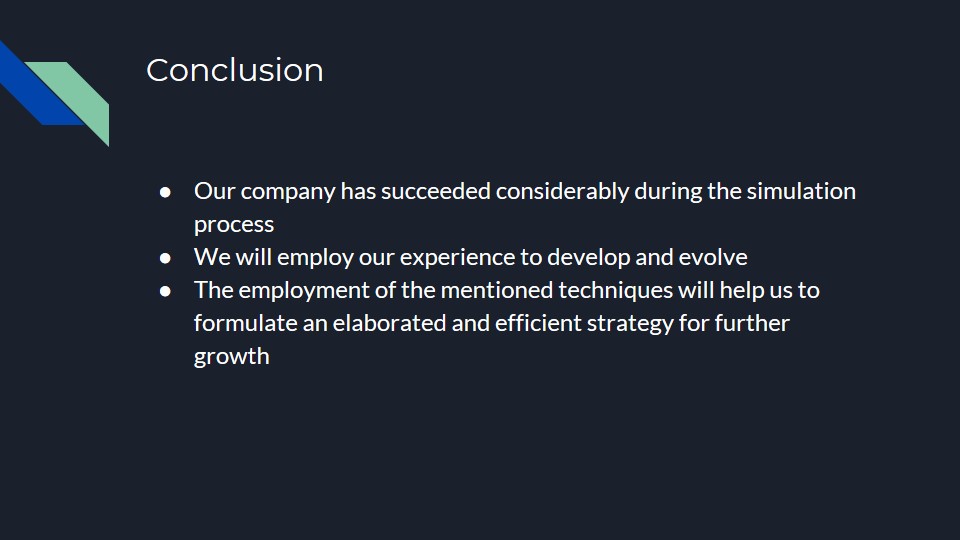
References
Aven, T. (2016). Risk assessment and risk management: Review of recent advances on their foundation. European Journal of Operational Research, 253(1), 1-13.
Cadle, J., Paul, D., & Turner, P. (2014). Business analysis techniques: 99 essential tools for success (2nd ed.). Swindon, England: BCS.
Gaspar, D., Coric, I., & Mabic, M. (2015). Data mining in customer profitability analysis. Advances in Economics and Business, 3(12): 552-559.
Jackson, G., & Ahuja, V. (2016). Dawn of the digital age and the evolution of the marketing mix. Journal of Direct, Data and Digital Marketing Practice, 17(3), 170-186.
Riel, J., & Martin, R. (2014). Integrative thinking 2.0: A user’s guide to your opposable mind. Rotman Management, 4-9.
Trainer, J. (2010). The Thomas–Kilmann conflict mode instrument. Web.
Tuckman, B. W., & Jensen, M. A. C. (1977). Stages of small-group development revisited. Group & Organization Studies, 2(4), 419-427.